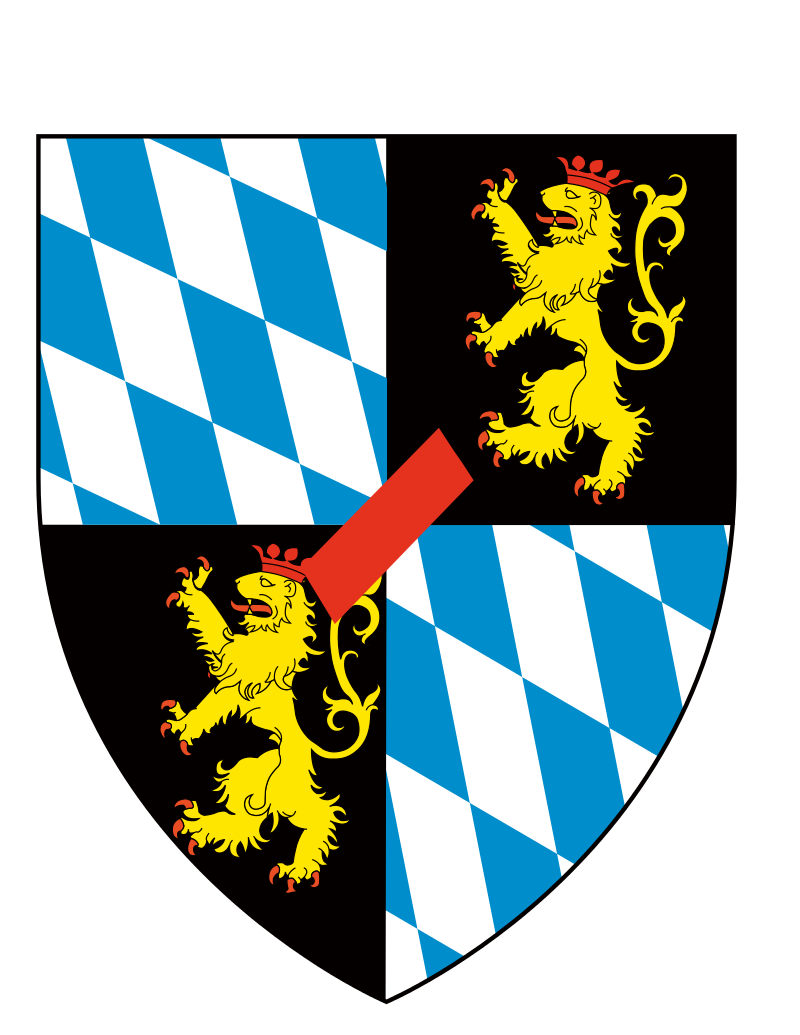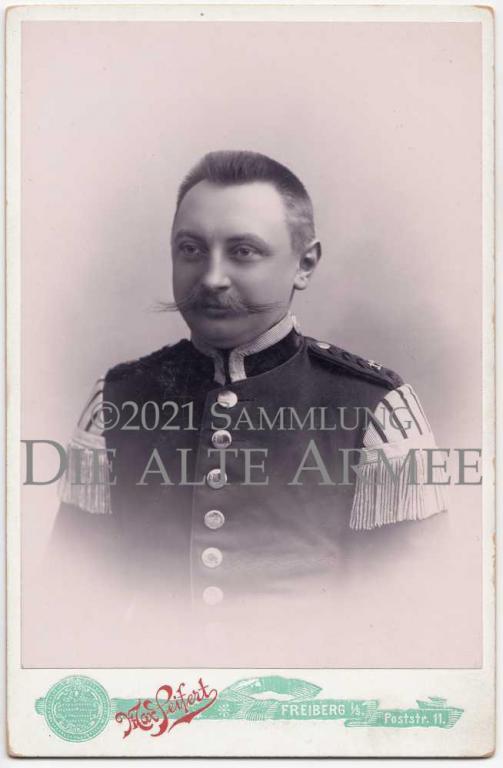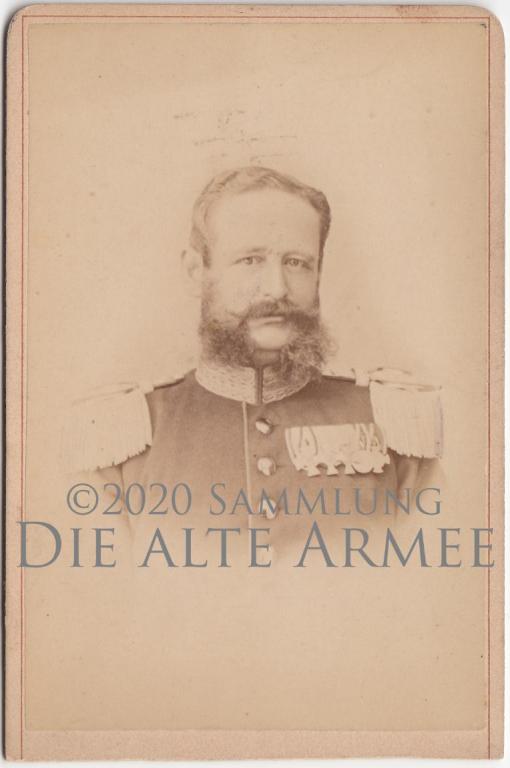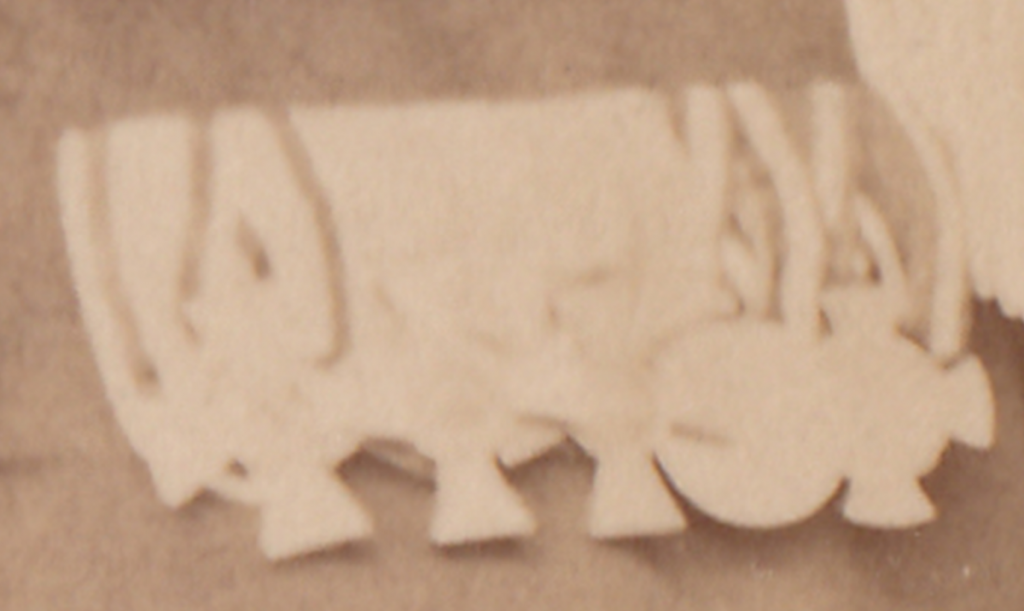-
Posts
359 -
Joined
-
Last visited
Content Type
Profiles
Forums
Blogs
Gallery
Events
Store
Posts posted by Utgardloki
-
-
14 hours ago, Deutschritter said:
Was Philipp zu Eulenburg also a General der Infanterie? Or is that maybe General der Infanterie August Graf zu Eulenburg??? Thank you!
I took the picture from the website of the Museum für Kunst und Gewerbe Hamburg (maybe I should have named the source; they put it in public domain by the way, which is nice)
They named it to Philipp zu Eulenburg, what I took over here.
But You are right, also from looking at photographs of both I think it is clear it is in fact August zu Eulenberg.
1 -
I overread that he had the red eagle 4 with swords. That makes it clear, it is the war ribbon. I guess he got it in 1866?
I think it is better to not link the black-white war ribbon only with the Iron Cross in our minds, but as its own entity, cause it was there before (first with PlM?, the Ordre de la Ordre de la Générosité had a full black ribbon to my knowledge.) and only happens to be the iron cross ribbon, cause it is a war-only decoration.
53 minutes ago, Daniel Krause said:Only the ribbons of the EK, another prussian war decoration or the lifesaving medal could be worn on the Überrock.
Was the jerusalem cross only worn as full decoration on the Überrock, cause I never saw a picture with only its ribbon being worn on it
1 -
On 25/01/2021 at 03:54, Deutschritter said:
Seeing he did not have the EK II (1870) or the Hohenzollern-Hausorden, what ribbon (Band im Knopfloch) could that be? Was the Orden vom Zähringer Löwen or the Hausorden der Wendischen Krone worn that way? Thank you!
He had an EK2
Here the 1903 ranklist entry

Edit:
Ah sorry, that's not his entry but that of General der Kavallerie Hermann Freiherr von Vietinghoff genannt Scheel (1851--1933) mentioned also in the other thread. Is it possible to delete this post?0 -
On 30/01/2021 at 14:47, juju1418 said:
The text is:
Sent to:
Hedwig Dellbrügge
Düren
Moltkestraße(? not 100% sure) 32Iserlohn, 30.11.18
Sehr geehrtes Fräulein!
Seit einigen Tagen gut in
Iserlohn, wo wir jedenfalls
noch länger bleiben.
Ich erlaube mir Ihnen diese
Karte mit meinen besten Grüßen,
auch an Ihre werten Eltern & Frl.
Schwester zu senden
Ergebenst
???
rough translation:Dear young lady (miss)!
Since some days good in
Iserlohe, where we gone
stay longer.
I take myself the liberty to
send You this card with my best
regards, also to Your valued parents
and sister.
Sincere
???
So a pretty generic text, with little information for us collectors
0 -
12 hours ago, 1812 Overture said:
Commander-level Isabella Catholic Order The following order I think is not Zellingen, but Russian Saint Ana
Ah, yes, you're right. Thanks!
0 -
Now searching for him in the forum, I found the thread again with the Hawaii order. There Geißler was als discussed a lot.
There is also an Austrian order of the Iron Crown 2nd class, he is wearing below the St. Stanislaus (How could I not see it, it is one of my favourite decorations)
Neck badge number 2 seems to be the württembergian Friedrichs-Orden Komtur 2. Klasse
0 -
Thank you so much!
The Isabella order is a really stunning.
0 -
I would love to know who this admiral is,
he's wearing:
neck insignia:
1: KO2
2: maybe hessian Philipp order ?
3: I remember seeing this one, but forgot what it is
4: Zähringer Lion commander 2nd class
5: Order of Saints Maurice and Lazarus commander
6: Swedish order of the Sword ?
7: Russian St. Stanislaus orderbreaststars:
1: a Scandinavian insignia ?
2: Russian St. Stanislaus order breast star
3: Chinese order (maybe double dragon) ?medal bar (left to right):
1: maybe RAO
2: long service
3: 1870/71 medal
4: centenary medal
5: what's that again?0 -
Thanks!
This explanation is exactly what I was hoping for.0 -
I have this photograph of the later Musikmeister Karl Giltsch - here in the uniform of a Stabshoboist of the 1. Jäger-Bataillon Nr. 12
(is this the uniform of a Stabshoboist? How do they differ from a Musikmeister ones?)
What is very interesting about this picture is that one can see the camera it was taken with on the reflections of the buttons.
 0
0 -
19 hours ago, The Prussian said:
Note, the title "Graf" was written before the name until 1920. ("Graf Ludwig von Holnstein"), After 1920 the "Graf" became part of the name.
That is the same that I read some years ago; true; after the new laws the titles became part of the name (not really as there is still the male and female form), so it is always "forename - title - surname", but this way of writing the names was already popular before. In Austria even more common than the title in front of the fist name form. It is most of the time something like "Franz Fürst Dietrichstein" or "Franz Fürst von Dietrichstein" not "Fürst Franz von Dietrichstein"; so it can be concluded that both forms were used before 1920.
0 -
5 hours ago, 91-old-inf-reg said:
This is very true. For a number of reasons, have it be the oil cloth hat, but the prevalent reason was due to the large trapezoidal ribbon bars the officers were known to wear at the front, thus distinguishing them from the average soldier for an enemy sniper, thus the change to the small 15mm ribbon-ribbon bars
Thank You for replying. I heard that too, but I think it only led to very few deaths. I don't believe a major reason for high casualties were ribbon bars.
And I wasn't referring to this unit, but rather generally. The info about those fallen officers above again strengthened my feeling that during the first months of the war the casualties among officers were very high. The reason might have been that the form of fighting war wasn't adapted to the new weaponry at that time. But maybe I am just wrong, it was only a "Bauchgefühl" as I would say in German. What would interest me is if there were more casualties among officers in the first months of WW1 compared to earlier wars and the later years of WW1.0 -
I somehow have the feeling that especially in the first few months of the war, especially many officers died. Is this a misconception by me or can it be proven?
0 -
So; here is the rest:
The third letter:
1. Marine-Inf.-Reg.
3. Komp.Im Felde, den 31. März 1918
Sehr geehrte Frau Sasse!
Ich erfülle hiermit die traurige Pflicht Ihnen
davon Nachricht zu geben, daß Ihr lieber Mann,
der Seesolfat d. Lands??? Otto Sasse, am 26. März 1918
im Angriffsgefecht bei St. Albert auf dem Felde
der Ehre gefallen und somit den Heldentod für's
Vaterland gestrorben ist.
Die Kompagnie verliert mit ihm einen bra-
ven, guten Soldaten, der in treuer Pflichterfüllung
für das Wohl seiner Lieben in der Heimat alles
hingegeben hat. Möge Ihnen daher in dem
großen Schmerze um seinen Verlust der Gedanke
ein Trost sein, daß sein Name in der Geschichte
des Regminets für alle Zeit fortleben wirdThe Iron Cross letter:
1. Marine-Inf.-Reg.
3. Komp.Im Felde, den 15. 11. 1917
An den
Seesoldaten Otto Sasse
Reserve-Lazarett II
Marienkrankenhaus, Hamburg
Die Kompagnie sandte heute an Ihre
dortige Dienststelle, das Ihnen auf die
Eingabe der Kompagnie hier, verliehene
E.K.II.
und bringt hierzu den herzlichsten
Glückwunsch zum Ausdruck
?????
Leutn. u. Komp. FührerAnd what's really sad, the backside of the photograph wich is dedicated to the third anniversary of the marriage to his wife. It cites a stanza of the poem "Ein Epilog" by Theodor Storm:
Meinem lieben Mausel(?), zum
6 Jahrestage unserer Ehe!Zage nicht, es muß sich wenden
Und heiter wird die Welt erstehn,
Es kann der echte Keim des Lebens
Nicht ohne Frucht verloren gehn.Flandern im Sept. 1917
Dein Otto!Unfortunately it took so long for someone to react to this post; I hope the opener of this thread is coming back, so we can see the photograph of Otto Sasse.
0 -
As there seems to be interest, here is the second letter:
Im Felde, den 3. Mai 1918
Hernn Bruno Abehitz,
Bln.-SchmargendorfDie letzte hiesige Gefechtstätigkeit macht es
der Kompagnie erst heute möglich Ihr wertes Schreiben
vom 10.10. Mts. zu bestätigen. Auf Ihre Anfrage sei
Ihnen zur Kenntnis, daß Ihr Stiefvater, der Seesoldat
Otto Sasse, am 26. März 1918 nachm. 5:30, als die Kom-
pagnie aus dem Orte la Baiselle nach Albert mar-
schierte, durch die Wirkung einer in die Kompagnie
eingeschlagenen feindlichen Granate sein Leben mit
noch mehreren Kameraden lassen mußte. Ein Splitter
in die Brust hatte sein Ableben auf der Stelle be-
wirkt. Beerdigt wurde er links der Straße Bapaume
- Albert, etwa 200 vom Südwestausgang von
la Boiselle mit noch fünf Kameraden seiner Kompagnie
in einem Grabe. Von dem Beerdigungskommando
ist die Erkennungsmarke seinerzeit nicht nach hier
zurückgegeben worden und dürfte es wohl aus-
sichtslos sein noh in den Besitz derselben zu gelan-
gen, zumal die Truppe welche die Beerdigung
vornahm, später selbst ins Gefecht eintrat.
Die Nachlaßsachen wurden dem auf dem
Felde der Ehre Gefallenen von einem Manne der Kom-
pagnie abgenommen. Dieser wurde dann selbst
verwundet und ist es ihm deshalb scheinbar nicht mög-
lich gewesen die einzelnen abgenommenen Sachen
alle zu bezeichnen, da ein Teil derselben hier ohne
den Vermerk über den Eigentümer einging.
Die Kompagnie hat sich bereits mit dem Manne
in Verbindung gesetzt und wird Ihnen nach
Abschluß der eingeleiteten Nachforschungen von
dem Ergebnis Mitteilung machen.
In voller Erkenntnis, welche schmerzliche
Lücke der in feindlicher Erde schlummernde Krieger
seinen lieben Angehörigen hinterlassen hat, wi-
derholt die Kompagnie ihre tiefste Teilnahme an
dem großen Schmerze.
Hochachtungsvoll
Schnackenberg
Leutnant d. R. u. Komp. Führer
0 -
3 hours ago, Chris Boonzaier said:
The "aus Bayern" is actually part of his title!
Yes it is a "bastard branch" (is there any less offensive sounding term? "illegitimate" doesn't fit really, i think) of the house of Wittelsbach. The coat of arms also bearing a "Bastardfaden" (Baton sinister), quite interesting.
 0
0 -
could it be Holnstein?
https://de.wikipedia.org/wiki/Holnstein_(Adelsgeschlecht)
Is there more text, it would be nice to see more of this handwriting.
0 -
Thanks a lot,
I am buying more photographs lately, but my knowledge about 19th to early 20th- century photography is quite limited.
I would be thankful for any suggestions on good books about the topic.
0 -
Thanks for sharing, interesting documents, showing the horrors of war
Here the quite moving first letter:
Im Felde, den 15. IV. 1918
Sehr geehrtes Frl. Schusch.. (?)!
Auf Ihre Anfrage vom 8. IV. über den Tod Ihres Onkels,
des Sees. Sasse(?), kann ich Ihnen Folgendes mitteilen: Beim Vorge=
hen auf Albert am 26. III. erhielt die Komp. einen Volltreffer,
bei dem Ihr Onkel durch Kopfschuß fiel. Er war sofort tot und hat
nicht gelitten. Mit fünf anderen gefallenen Kammeraden ist
er beerdigt worden. Das Grab liegt östl. Albert in einer Mulde,
wo er den Heldentod gefunden hat an der Straße Albert-Bapaume
Unter den augenblicklichen Kampfhandlungen ist es natürlich schwer,
eine Photographie des Grabes zu machen, aber später wir es
natürlich möglich sein.
Hochachtungsvoll
Schna...
Ltn. d. R. u. Komp. Führer.0 -
Thanks!!!
I was a bit suspicious, that's why I posted it here. And now, after looking at it again, the way it was made doesn't actually look like it was taken around 1910.
0 -
The picture was taken in Plön and he is wearing:
RAO4; KO3; Dienstauszeichnung; 1870/71 medal ? ; one of the 1866 crosses?
so I concluded it has to be Oberstleutnant Billig, cause the decorations would fit; he might got the OV3 WF3a after the picture was taken.
could this be a possibility or could I be wrong?
(entry from the 1914 ranklist)
0 -
I wonder if there are still bubbles in it ?
0 -
True, he almost looks exactly like the "perfect Hitler", you would imagine when thinking of such a picture... I remember being a bit disappointed after I have first seen the WW1-Hitler, not looking as hitlerish as I imagined... (hmm - that's a weird sentence)
0 -
The article I posted above states an enlargement was already done in the 1920s.
I wonder if this one with the circled enlargement is the only one around. I would call it highly suspicious if there isn't a high resolution version of this picture with Hitler in it, from which everyone in the crowd can be enlarged in the same quality. I hope it's clear what I mean, it's hard in English...
0









Sturm-bataillon ....
in Germany: Imperial: Rick (Research) Lundstrom Forum for Documentation and Photographs
Posted · Edited by Utgardloki
That's cause there were 2 different writing styles taught in Germany (the wohle German Sprachraum actually - including Austria, Switzerland etc.) Both in printed texts and handwritten ones. Everything in German was written in the German font, everything in romance languages in Latin font.
For printed German text a gebrochene Schrift (broken font) or blackletter ist used, for printed text from a romance language a runde Schrift (round font) is used, the Antiqua (which it is the dominant today)
They were very strict with this, even germanised words from romance languages were set in Antiqua. Here for example a book about heraldry, I was reading lately from 1714:
Geneologie is printed in Antiqua as it has no German origin.
It goes so far that when a word originating in another language, that is germanised, the root of the word is set in Antiqua, but the part, which comes from German grammar, is set in the broken font.
Here for example Conversationen (english: conversations) has the Latin root "conversatio" set in Antiqua, but the ending "nen", which is there to make it apply to German grammar is set in broken font
For handwritten texts there was/is also a broken variant and a round variant. The round variant is more or less equal to the englisch cursive and can be called Lateinische Schrift (Latin font). The broken variant, used for German language words (therefore of course also in your postcard) uses almost (not really as still is just a style of the Latin alphabet) a completely different set of letters (at least one gets the impression it is so), which is oriented on the broken printed letters.
Now it mostly is called Kurrentschrift or Sütterlinschrift, which both isn't satisfying to me (actually annoys me, but of course one can use the terms cause anyone knows what is meant).
Why?
First Kurrentschrift comes from currere (latin running, german laufen), so just means Laufschrift (roughly running or current font or just cursive font), which just means that the letters used in a word are connected (made without lifting the nib). That is also true for the round, the Latin font, it also is a Kurrentschrift which one can actually call lateinische Kurrentschrift (Latin running font or latin cursive), if one wants to. So in conclusion Kurrentschrift isn't a satisfying term to distinguish the fonts.
Second Sütterlinschrift is even worse. It is a handwriting font designed by Ludwig Sütterlin in 1911, that is just a simplified, easier to learn version of the earlier used ones, that you can write without a flexible nib (the stroke has the same thickness everywhere). And now there is the punchline: Of course he designed a German (broken) one and a Latin (round) one. There are 2 different Sütterlinschirften. So again this term actually can't be used to distinguish both.
How should we call it?
The broken font: gebrochene Schreibschrift (broken handwriting) or deutsche Schreibschrift (German handwriting)
The Latin font: runde Schreibschrift (round handwriting) or lateinische Schreibschrift (Latin handwriting)
It is actually no shame to be unable to read it, you have to learn it, almost like learning a different alphabet. Almost no german-speaking person is able to read it, the young ones don't even no it existed (I am quite young too, and most of my friends and acquaintances of same age hardly heard of it). Why? In Switzerland is was already abolished earlier (beginning of 20th century) I think, but I don't know exactly. In the rest of the german-speaking countries it was abolished with the Normalschrifterlass (literally normal-font(writing)-decree) in 1941. Both the printed broken letters and the handwritten ones were no longer used. The national-socialists made an obscure connection of it with Jews and therefore it should be abolished, somehow ironic as today blackletter is almost always used in films etc. when referring to the Nazis. In the 1950s and 60s it was again taught, but hardly used and therefore slowly disappeared.
My grandmother (born in the 30s) for example can more or less read it, but no longer write it.
Another interesting fact is, that when I was in primary school (which isn't that long ago), we still called the connected handwriting Lateinische (The Latin), although we never heard of a "The German". Later in school my math teacher, who was into such things and actually learned it in school (born in the 1950s I guess), sometimes used it jokingly to label vectors in math (like it was done it the past; convenient to have a third set of symbols, beside the Latin and Greek ones) to confuse us. That's were I actually first got interested to it and started to learn to write it (both the German Sütterlin variant and the older one done with a flexible nib). And in my opinion learning to write it is the easiest way to also learn to read it.
PS:
It was a widely used practice to write names in the Latin font, like in Your postcard. Some people tended to write only in the Latin font, that's why you said some are easier to read.
Would be nice if You post it